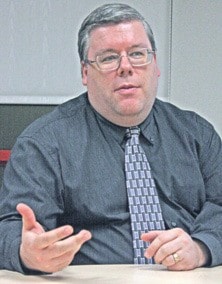By Jasmine Franklin
In a world built around the Internet and social networking, the importance of online safety is something Mecca Glen hopes will be discussed and brought into the homes of families.
“Your online choices have offline consequences,” said speaker Mark McWhinnie, technology integration director of Wolf Creek School Boards. “Think carefully about who you talk too, and what you share.”
On Feb. 16, McWhinnie spoke to a group of teachers, parents and students about the need for guardians to take charge and get involved with their children’s online activity.
The evening focused on informing parents of the new Web 2.0 trends – social networking and online communities.
Social networking sites come in the forms of Facebook, Twitter, Nexopia, Second Life, MSN Messenger and any other sites that allow people anywhere in the world to connect at any time.
“The Internet used to be a resource of information,” McWhinnie said. “Now it’s a source of information but also an interactive environment.”
Now with the Internet, any person can set up blogs, sort of an online version of a diary, share videos and photos, and express their individual tastes.
What many users of the Internet perhaps don’t consider so often is the dangers.
“Once you post something on the Internet, it’s almost impossible to permanently get rid of,” McWhinnie said. “The Internet is like a knife – it’s a tool that has to be used properly or you can get hurt.”
How can guardians and users of the Internet, ensure the tool is handled appropriately?
Advice for parents: set guidelines
Firstly, McWhinnie stressed that guidelines and restrictions regarding the use of the Internet should be established in every home.
“Make sure to outline what they can and cannot do online,” he said. “Every child needs boundaries and that shouldn’t stop at the Internet.”
According to Canadian statistics, 74 per cent of family homes have rules about meeting an Internet friend in person. Having rules reduces the chance of children meeting an online friend by half.
“The Internet can’t consume their lives,” he said.
In McWhinnie’s presentation it was revealed that half of teenagers have computers in their bedrooms and teens use the Internet for about three hours a day.
Get involved with their online life
“This is their world — groups have evolved and they can build communities all online,” McWhinnie said. “Don’t be afraid to be the student and have them be the teacher. Develop a deeper and better understanding of the Internet.”
McWhinnie suggests joining your children’s blog and discussing the topics they write about, become a “friend” on their Facebook page and view their site the way the public can.
“Get them to show you their privacy settings,” he said. “Have that discussion with them of what is okay and not okay to post and always remind them to think about what they are sharing over the Internet. The more information anyone shares about themselves the more information is available.”
Online “friends” is also an important discussion to be had at home McWhinnie encourages. Children and teens should think about who they are really talking with and how much they really know about them.
McWhinnie’s basic Internet activity rules
•Keep personal information private
•Keep privacy settings tight
•Never meet alone in person with someone you have met online
•Don’t post plans or whereabouts
•Consider the possible consequences before posting information or photos of yourself
•Ensure parents know of online activity.
•Don’t share passwords
For additional information for parents on the Internet and safety visit www.commonsensemedia.org, www.beweaware.ca, www.media-awareness.ca, www.netsmartz.org or www.pointsmartclicksafe.org
